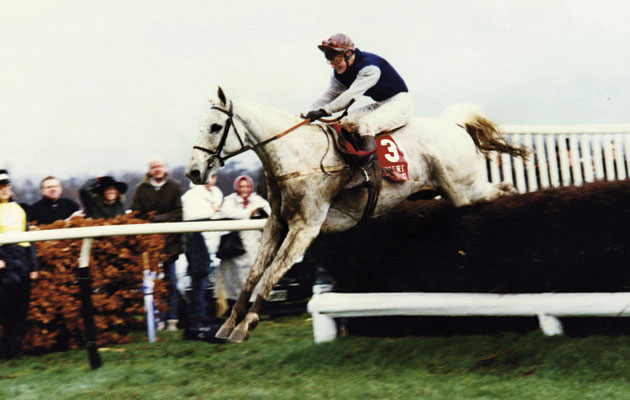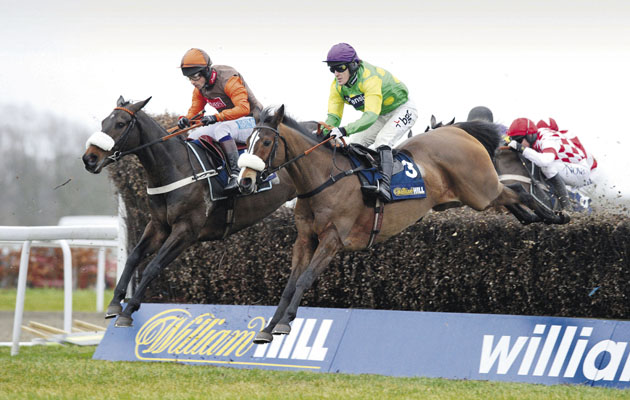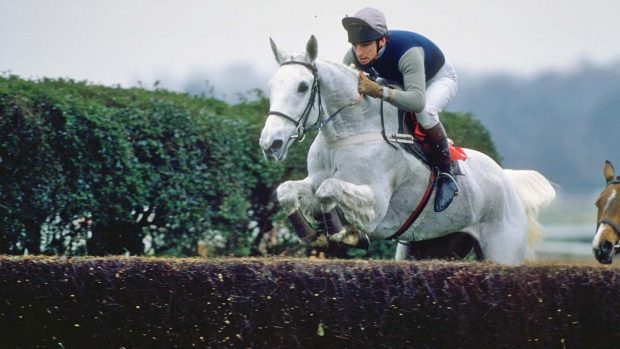A swashbuckling grey with an unquenchable zest for racing, Desert Orchid lit up the National Hunt scene during the 1980s with his showboating charisma, says Julian Muscat, as we celebrate Horse & Hound’s 140th anniversary in 2024
It started as it would end eight years later, with Desert Orchid lying prostrate on the Kempton turf after a crashing fall.
On his 70th and final outing the popular grey fell heavily in the 1991 King George VI Chase. The nation held its breath until Desert Orchid rose quickly, unhurt and was ushered straight into retirement. But that fall on his racecourse debut was something else entirely. He’d run himself legless when he barely got airborne at the final flight. Then he lay down for what seemed like an eternity.
“At that time his enthusiasm outweighed his technique and his experience,” relates Desert Orchid’s trainer, David Elsworth, in his soft, West Country lilt. “When he turned over, it looked serious.”
The tell-tale green screens hoisted around him seemed to tell their own story.
“When I saw the screens, I started walking towards where he was lying,” Elsworth continues, “and when I was 50 yards away, the bugger suddenly got up. Turned out he was only winded, but what a tragedy that would have been. Nobody would have heard of him.”
That near-calamity on his debut was emblematic of Desert Orchid’s early years. He was headstrong and impulsive at home, and it nearly cost him dearly. Yet under Elsworth’s intuitive eye and exercise rider Rodney Boult’s supple hands, he would evolve into the most charismatic racehorse of the 20th century. The public adored him. At its height Dessie-mania was just as impassioned as Beatle-mania.
And no wonder. After a winless first season when he ran four times, Desert Orchid blossomed in 1983/84. A winning streak of six included the Tolworth Hurdle at Sandown. On that day he toyed with Ihaventalight, who was the apple of multiple champion trainer Fred Winter’s eye.
“Funnily enough I bumped into Fred in the gents’ afterwards,” Elsworth says. “He looked at me over his glasses with those beady eyes and said: ‘That horse of yours is good, isn’t it?’ I told him it was.
“Then he rang me at home a few days later. All he said was: ‘How much?’ and I replied: ‘Fred, I’m afraid he’s not for sale.’ Those were the only words we exchanged. He didn’t need to tell me which horse he wanted to buy, just as I didn’t need to ask him.
“So there you are: Fred was on to Dessie already,” Elsworth continues. “He was a hard, competitive, mean-looking so-and-so, and a great judge. I liked him.”

Two months later Desert Orchid started second favourite for the Champion Hurdle but finished well down the field behind Dawn Run.
“We were bitterly disappointed because at the time we had no idea how ineffective he was going left-handed,” Elsworth recalls.
It was a trait that stayed with Dessie, who was owned by the Burridge family, throughout his career. There was no telling why he wasn’t as good when racing around left-handed turns. “It’s like a ship: you can have the best sails but you go nowhere unless you have the wind behind you,” Elsworth says.
Nevertheless, Desert Orchid’s front-running style, along with his near-white coat, already marked him down as something out of the ordinary. He had a largely unproductive third season before Elsworth announced he would be campaigned over fences during the 1985/86 campaign.
“I kept being told the horse wanted two miles over hurdles on fast ground,” the trainer reflects. “I begged to differ. I felt he was always in too much of a hurry over hurdles, which is why he had a few falls. Anyway, he racked up another sequence over fences and then I stepped him up to three miles for the 1986 King George. Everybody thought I’d finally gone mad.”
That King George triumph on Boxing Day saw Desert Orchid sear his image into the nation’s soul. Elsworth had another runner in Combs Ditch, who had finished runner-up in the previous two renewals. His stable jockey, Colin Brown, plumped for Combs Ditch, so Simon Sherwood was summoned.
“I didn’t know too much about Desert Orchid at that stage,” Sherwood says. “I knew he was a firebrand type who liked to lead and jump extravagantly. Other than that, I had no take on the race whatsoever. David told me to ride him as though he would stay, and said he was more likely to switch off if I let him do his own thing.”
Sherwood never saw another horse. Galloping with zest and flying his fences, Desert Orchid built up a clear lead by halfway and was never threatened.
“The horse got into a lovely rhythm,” the jockey recalls. “I’m sure the others ignored me, thinking I was riding a head-banger, but when I turned for home I was still on a full tank.”
Dessie won by 15 lengths and the legend was born. The swashbuckling grey who tore off at breakneck speed had somehow stretched himself out over three miles. He could now take in any race his connections chose. Two miles or three, fast ground or testing: it made no difference to the horse, whose public fan club was growing apace.
Desert Orchid would become a standing dish at Kempton over Christmas, where he won four King Georges in five years. He was runner-up in 1987, when Brown, reunited with Dessie, went too fast early on and was picked off in the straight.
It was the second of five successive reverses for Dessie with Brown in the saddle, and when Brown retired soon after partnering the horse into second place in the 1988 Champion Chase at Cheltenham, Sherwood resumed a partnership that never looked back.
Some things are just meant to be. As with Frankel’s debt to Sir Henry Cecil, Desert Orchid might never have flourished had he been entrusted to the wrong hands. But David Elsworth’s ambitious yearning matched that of his grey crusader. He was every bit as indomitable as the horse he trained.
The key was that for all Dessie’s natural flamboyance, for all the skittishness of his formative years, he was a horse who thrived on hard graft.
Elsworth almost winces when he remembers how he kept Desert Orchid at concert pitch at his Whitsbury stables, in Hampshire.
“If he was running on a Saturday, I’d send him over 1½ miles on the round gallop, which finished uphill,” he says. “Dessie would tank up that hill, always on the bridle but full of it.
“He probably would have won without me putting him through that, but it made me feel better when he did it. And he could certainly take it. Most trainers wouldn’t dream of doing that three days before a race. Maybe with a Flat horse over seven furlongs, but not a three-mile chaser.”
For all that, one of Desert Orchid’s endearing qualities was his longevity. He won 34 races from 70 starts. Indeed, Desert Orchid made as many starts as Denman, Sprinter Sacre and Best Mate put together.
The horse thrived on competition, and Elsworth made sure he saw plenty of it.
“He usually ran six or seven times each season,” he says. “It wasn’t planned that way, it was just that those of us working with him knew he could do it.”
There was another reason for Desert Orchid’s regular racecourse sightings. Elsworth grew up the hard way: an illegitimate child who spent much of his youth catching rabbits with his dogs on Salisbury Plain and selling them in local markets. He rode a bit under Rules until he felt compelled to turn his hand to training. He was determined to show the jumping fraternity he could outdo them all. He wasn’t afraid of saying so, either.
His prowess with horses was sublime. In 1989, having saddled Dessie to win the Gold Cup at Cheltenham in March, David followed up in June with a Royal Ascot double – thanks to Indian Ridge, a seasoned sprinter, and Dead Certain, a precocious two-year-old filly. He had every right to shout from the rooftops.
“To be honest – and for all my faults, I am honest – I ran Dessie most Saturdays because I wanted to make as much money as I could,” he says with typical candour. “I certainly wasn’t abusing him; every time he ran I thought he could win. And he retired sound after 70 races, way more than most chasers run these days.”
Dessie was also one of the last top-class chasers to make regular forays into handicaps.
“That’s what made him unique,” Sherwood says. “He carried 11st 11lbs in the 1988 Whitbread and he won with a stone in hand over three miles five furlongs.”
This was Desert Orchid in his prime. His popularity reached new heights during the 1988/89 season, when he won the Tingle Creek Chase, then a handicap over two miles, with 12st on his back. He then routed old foe Kildimo to win his second King George over three miles.
“David then sent him back over two miles for the Victor Chandler Chase,” Sherwood remembers. “He carried 12 stone and beat Panto Prince [the winner of 15 races in his career] in a photo when giving him 22lbs. That was a proper scrap. It was all happening a bit too quickly for him but he still found a way.”
So imperious had Desert Orchid become that Sherwood admits to having showboated aboard a horse who was also inclined to indulge increasingly devoted galleries on the racecourse.
“In the 1989 Gainsborough Chase I remember people saying he would meet his match in Pegwell Bay, who was seen as the next big thing,” Sherwood relates. “Dessie was giving him lumps of weight [18lbs] and Carl Llewellyn [aboard Pegwell Bay] came up to head me at halfway.
“Carl was chuckling, thinking he had me in trouble, but I was just toying with him. You could do that with Dessie, because he could make you feel invincible. So I moved back up to Carl at the second-last and said: ‘Is that all you’ve got?’ before we went away again.”
The 1988 Whitbread was another instance. “We played with runner-up Kildimo that day,” Sherwood says. “He was one of the best chasers around and we treated him like a beginner.”
As for Dessie, he loved running at Sandown, where the buzzy grandstands are close to the track.
“He was a sod to get down to the start there,” Sherwood says. “He’d cock his head towards the crowd and there was nothing you could do about it. He had an empathy with his following. He was a real showman with tremendous charisma. I suppose another reason why the crowds loved him was because he was a rags-to-riches horse, having been bred to run in point-to-points.”
For all the drama he generated, and despite his litany of achievements – including winning the 1990 Irish Grand National with 12 stone on his back – Desert Orchid reached his zenith in the 1989 Gold Cup at Cheltenham. He’d run at five previous Festivals without success, and he was now 10 years old. Victory in the blue riband would gild an outstanding career.
“What a day that was,” Sherwood says with a sigh. “The weather was filthy and conditions took their toll on some of the fancied horses. It came down to guts in the end, and in those circumstances you could count on Dessie to come out on top.”
Dessie duly did, although he looked beaten when Tom Morgan aboard Yahoo headed him on the run to the final fence. But as Yahoo started to idle in front, Sherwood galvanised Desert Orchid for one last lunge. As Dawn Run had done to Wayward Lad in 1986, Dessie ground Yahoo down after the last and the grandstands erupted.
“I remember I had my private moment with him before we headed towards the winner’s enclosure,” Sherwood recalls. “As we walked back through the paddock a surge of people ran towards us.
“In those moments you pick out a few faces in the crowd: I saw the woman I would marry and the Queen Mother, who had a beaming smile on her face. Then they gave us ‘three cheers’. I’d seen Jonjo O’Neill and Dawn Run do it three years earlier, when the reception was incredible, and here I was on this amazing horse.”
There would be other top-flight victories. Richard Dunwoody took over on Sherwood’s retirement and won two more King Georges. Their attempt to win a third in 1991 met with the fall that prompted Dessie’s retirement. The horse spent it alternating between David Elsworth in winter and summers spent in the Burridge family’s Leicestershire paddocks.
Elsworth trained several top-class horses under Flat and National Hunt Rules, yet Desert Orchid has no peer in his affections. As much is evident from the pictorial shrine to the grey on the walls of David’s home.
“It was an extraordinary time,” the trainer reflects. “When you’re in the driving seat with a horse like that, you see things differently to everybody else. You’re on the inside looking out. It becomes personal.
“You realise over time that trainers and jockeys ride on the back of horses, who are the real stars. But you live and learn. At that time I was aggressive; always trying to pedal the bike too fast. I now know that whatever you do in life, you need to be lucky. And I was very lucky to have had Desert Orchid.”
Desert Orchid by numbers
Won 34 of 70 starts, including:
Cheltenham Gold Cup 1989
King George VI Chase 1986, 88, 89, 90
Whitbread Gold Cup 1988
Gainsborough Chase 1987, 89, 91
Tingle Creek Chase 1988
Victor Chandler Chase 1989
Irish Grand National 1990
Tolworth Hurdle 1984
Kingwell Hurdle 1984
Desert Orchid’s origins
Grey gelding, foaled 11 April 1979
By Grey Mirage out of Flower Child, by Brother
Owner: Richard Burridge et al
Trainer: David Elsworth
Breeder: Jimmy Burridge
Regular jockeys: Colin Brown, Simon Sherwood, Richard Dunwoody
Desert Orchid’s granddam, Grey Orchid, was bought by Jimmy Burridge for £175 and reared over with him the first time he sat on her. Grey Orchid failed to win in point-to-points – including when finishing second in a two-runner race. She produced Flower Child, who won once under Rules before she was bred to Grey Mirage in 1978. Desert Orchid resulted from that union.
Desert Orchid’s riders
Dessie had a number of regular riders, but which one got the best out of him?
“I’d love to say Colin Brown because he was my stable jockey and a mate,” says David Elsworth, who trained Desert Orchid.
“Colin was instrumental in the horse’s early years – the combination won 17 races – but Simon Sherwood rode the horse for the first time in the 1986 King George and I was keen for him to get back on him even though he didn’t ride much for me at all.
“Richard Dunwoody [pictured] was a proper jockey, one of the best, yet while he won many big races on Dessie, by and large he wanted to organise his horses. Dessie was one of those who didn’t want organising. He was best left to his own devices because he was always willing.
”With Simon, the horse felt like he was running loose.”
Too beloved for the National
At the height of Desert Orchid’s popularity, connections seriously considered running him in the Grand National, in which he would have been asked to carry top weight. That prospect had the nation on tenterhooks.
“I’m sure he’d have been absolute mustard round Aintree,” says Simon Sherwood, who rode Desert Orchid to win nine times from 10 starts. “Becher’s would have been something, especially if he took off on a long stride. But there was little to gain and too much to lose if anything awful happened – not that I think it would have. And the weight might have told on him over four-and-a-half miles.”
David Elsworth was keen to go but there were other concerns.
“It would have been some sight, but by then, the pressure was building on all of us because the old horse was like public property,” he says. “Some of the Burridge family weren’t too keen, and they owned the horse, so it wouldn’t have been right if they weren’t going to enjoy it. And maybe part of me was also looking for a reason not to run him, even though I think he might well have won it.”
You might also enjoy reading…

Legends of the sport: Showjumper Marion Mould with her pony Stroller *H&H Plus*
The teenage girl on a pony that conquered the world stage has become the stuff of showjumping legend. Penny Richardson

Horse & Hound’s 140th anniversary legends: Milton – John Whitaker’s wonder horse who won over £1m during his career

Legends of the sport: Happy 70th birthday to six-time Badminton winner Lucinda Green

Legends of the sport: 20-time champion jockey AP McCoy *H&H Plus*
As record-breaking careers go, few compare to that of 20-time champion jockey AP McCoy. From Grand National glory to knighthood,

Best Mate: the three-time Cheltenham Gold Cup victor immortalised in bronze
This three-time Gold Cup winner became the “people’s champion”, earning himself comparisons with the mighty Arkle. Hannah Lemieux delves deeper

Subscribe to Horse & Hound magazine today – and enjoy unlimited website access all year round
Horse & Hound magazine, out every Thursday, is packed with all the latest news and reports, as well as interviews, specials, nostalgia, vet and training advice. Find how you can enjoy the magazine delivered to your door every week, plus options to upgrade your subscription to access our online service that brings you breaking news and reports as well as other benefits.



